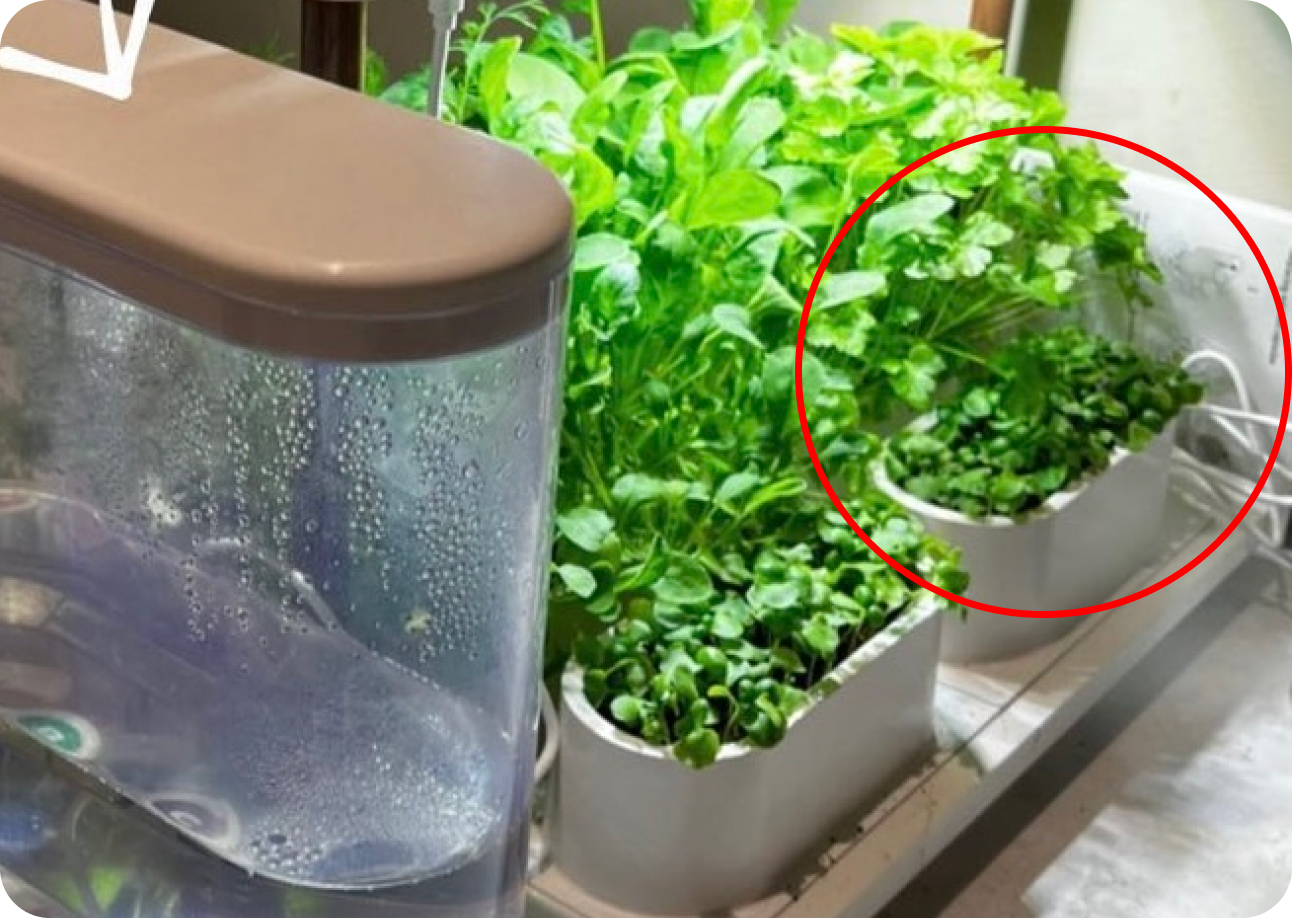Summary:
- If the soil is dry, pour 3-4 dl (1.5 cups) of water into the baseplate.
- The optimal temperature is 20-25°C / 68-80°F
- Keep the light approx. 10 cm / 4" above the plants
- Make sure all plants get enough light
- Harvest regularly for the best growth
- Set the light cycle to decide when the light turns on
- Is the light too bright? Dim it down to get a warm, cozy vibe
Tip 1: If the soil is dry, pour 3-4 dl (1.5 cups) of water into the base plate.
Once in a while, your plants can go dry – typically if there’s a sudden spike in temperature or sudden acceleration of plant growth.
If this happens, just lift a pot and pour 3-4 dl (1.5 cups) of water into the baseplate. This will help your Auk recover and water normally again.
If a pot goes dry, pour 3-4 dl of water into the baseplate, and your Auk (and plants) will recover.
Tip 2: The optimal temperature is 20-25°C / 68-80°F (growth is very slow below 19°C / 66°F)
Temperature is important for plant growth, and the perfect temp is 20-25°C / 68-80°F. If it drops below 19°C, the growth can slow down significantly – plants don't like to freeze :)
If you can, place your Auk somewhere warm.
Tip 3: Keep the light about 10 cm / 4" above the plants
Plants reach for light, and if the light is too far away, they'll grow tall and thin. If the light is too close (or they grow into the light), they might get burnt.
It doesn’t have to be exactly 10 cm /4", but that’s a good rule of thumb👌🏻
As the plants grow, simply pull up the plant light.
Tip 4: Make sure all plants get enough light
Some plants (like arugula and parsley) grow fast and can overshadow slower ones like basil and oregano. Plants need lots of light to grow, so make sure none of them are in the shadow.
If large plants cast shadows, it’s smart to trim the biggest leaves. You can also place smaller plants in the middle where the light is strongest.
Here, the larger plants overshadow the basil. To make sure it gets enough light, you could trim the large plants and/or place the basil pot in the middle, directly below the light.
Tip 5: Harvest regularly for the best growth
Harvesting regularly stimulates new growth, giving you healthy, thriving plants.
A good rule of thumb: Wait until the herbs are 10-15 cm / 4-6" tall before harvesting. They should have at least two pairs of leaves. It's perfectly fine to wait until they’re larger as well.
A second good rule of thumb: Harvest max ⅓ of the plant at a time. As long as you don't cut off the whole plant, it usually grows back nicely!
Learn more about harvesting herbs and salads.
Learn more about growing tomatoes.
Learn more about growing chili and peppers.
Tip 6: Set the light cycle to decide when the light turns on
You can choose when the light turns on by setting the light cycle. To set the light cycle, hold the light button for 5 seconds until the light turns off and back on again.
After setting the light cycle, your Auk will turn on at the same time every day.
Example: If you set the light cycle at 07:00, your Auk will have the light on during the day and turn it off at night, before turning it on again at 07:00 the next day.
Light cycle for herbs & salad program (green plant chip):
- Phase 1: Light is on for 12 hours, then off for 12 hours
- Phases 2-5: Light is on for 16 hours, then off for 8 hours
Light cycle for tomato & chili program (red plant chip):
- Phase 1: Light is on for 12 hours, then off for 12 hours
- Phase 2: Light is on for 16 hours, then off for 8 hours
- Phase 3: Light is on for 14 hours, then off for 10 hours
- Phases 4-5: Light is on for 12 hours, then off for 12 hours
Tip 7: Is the light too bright? Dim it down to get a warm, cozy vibe
Tap the light button once to dim the light. The dimmed light creates a pleasant atmosphere, perfect for dinner parties 😊
Tap the light button once to dim the light
Note: The light will be dimmed until the next light cycle starts (unless you tap the light button 2 times to turn it back on). Then it will turn on again at full strength. Learn more about the light cycles here.
Don't hesitate to contact us at hello@auk.eco if you have any questions, or look around at our other articles 🌱







